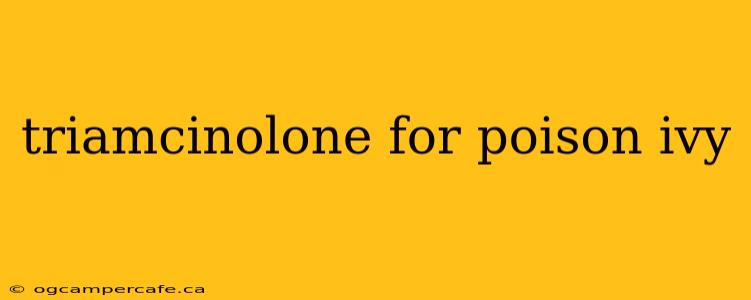Poison ivy, with its infamous rash and intense itching, is a common summertime nuisance. While various treatments exist, many find relief using triamcinolone, a potent corticosteroid. This post delves into the effectiveness of triamcinolone for poison ivy, its various forms, application methods, and potential side effects. We'll also discuss when to seek professional medical attention.
Understanding Triamcinolone and its Action Against Poison Ivy
Triamcinolone acetonide is a synthetic corticosteroid. It works by reducing inflammation, suppressing the immune system's response to the urushiol oil in poison ivy, and relieving itching. This multi-pronged approach makes it a highly effective treatment for the symptoms of poison ivy. It doesn't remove the urushiol oil itself, but it significantly reduces the body's reaction to it.
Different Forms of Triamcinolone for Poison Ivy Treatment
Triamcinolone is available in several forms, each suited for different stages and severities of poison ivy reactions:
- Cream: A popular choice for its ease of application and moisturizing properties. It's best suited for mild to moderate rashes.
- Ointment: Ointments are thicker and more occlusive than creams, providing longer-lasting moisture and potentially better symptom relief for dry, cracked skin.
- Lotion: A lighter consistency than cream, lotions are suitable for large affected areas and may be less greasy.
Applying Triamcinolone for Optimal Results
The effectiveness of triamcinolone hinges on proper application. Always follow the instructions on the packaging, but some general guidelines include:
- Clean the affected area: Gently wash the rash with mild soap and water before applying the medication.
- Thin layer: Apply a thin layer of triamcinolone to the affected area, ensuring full coverage. A thicker layer won't necessarily work faster or better.
- Frequency: Follow the prescribed frequency, typically 2-4 times daily.
- Gentle application: Avoid rubbing or scrubbing the area.
Potential Side Effects and Precautions
While generally safe, triamcinolone can cause side effects, particularly with prolonged use or application to large areas:
- Skin thinning: Long-term use can thin the skin, making it more susceptible to damage.
- Striae (stretch marks): These are possible, especially in areas prone to stretching.
- Burning or stinging: Some individuals may experience a temporary burning or stinging sensation upon application.
- Allergic reactions: Although rare, allergic reactions are possible.
Important Note: Triamcinolone should not be used on the face for extended periods without consulting a doctor.
When to Seek Medical Attention
While triamcinolone is effective for many, it's crucial to seek medical attention if:
- Severe reaction: The rash is widespread, severely painful, or accompanied by fever, swelling, or difficulty breathing.
- No improvement: The rash doesn't improve after a few days of treatment.
- Secondary infection: Signs of infection, like increased pain, pus, or red streaks, appear.
Conclusion: Triamcinolone as a Valuable Treatment Option
Triamcinolone is a valuable treatment for poison ivy, effectively alleviating symptoms like itching and inflammation. However, it's vital to use it correctly, be aware of potential side effects, and seek professional medical advice for severe reactions or lack of improvement. Remember to always read and follow the instructions on the product packaging. This information is for educational purposes only and should not be considered medical advice. Always consult a healthcare professional for any health concerns or before starting any new treatment.
